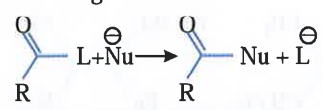Which gives nucleophilic addition reaction?
Hydrolysis of ethyl chloride by NaOH
Purification of acetaldehyde by NaHSO3
Alkylation of anisole
Decarboxylation of acetic acid
The correct Answer is:B
Step by step video & image solution for Which gives nucleophilic addition reaction? by Chemistry experts to help you in doubts & scoring excellent marks in Class 12 exams.
Updated on:21/07/2023Topper's Solved these Questions
Similar Questions
Knowledge Check
An aldehyde can give nucleophilic addition reaction with :
AHCNBNaHSO3CR-Mg-XDNH2NH2Aldehydes and ketones are amphoteric. Thus they can act both as acids and bases. Under acidic conditions, the carbon of the protonated canbonyl group is much more electrophilic, reacting even with weak nucleopphilie. Carbonyl compound gives nucleophilic addition reaction. In this reaction the nucleophilic attack proceeds the elecrophilic attack.
Carbonyl compounds gives nucleophilic addition withAcarbon nucleophileBoxygen nucleophileCNitrogen nucleophileDAll of theseStatement-1: Aldehyde and ketone give nucleophilic addition reactions with carbon oxygen, nitrogen and sulphur nucleophiles.
Statement-2: Sulphite ion is ambident nucleophile.AStatement-1 is True, Statement-2 is True, Statement-2 is a correct explanation for statement-4Bstatement-1 is true, statement-2 is true, statement-2 is NOT a correct explanation for statement-4Cstatement-1 is true, statement-2 is falseDstatement-1 is false, statement-2 is true
Which one is most reactive towards nucleophilic addition reaction?
View SolutionWhich carbonyl group of the given compound is most reactive for nucleophilic addition reaction ?

View SolutionWhich one is most reactive towards nucleophilic addition reaction?
View SolutionWhich one is most reactive towards nucleophilic addition reaction?
View SolutionAldehyde, ketone, carboxylic acid derivatives contain C= O group. Aldehyde and ketones give nucleophilic addition reactions where as acid and acid derivatives give nucleophilic addition followed by elimination reactions. Nucleophilic addition reactions followed by elimination of acid dervatives is Known sacyl substitution reaction. This substitution reaction takes place by formation of tetrahedral intermediate. For the given reaction

which of these is correct ?
View Solution
